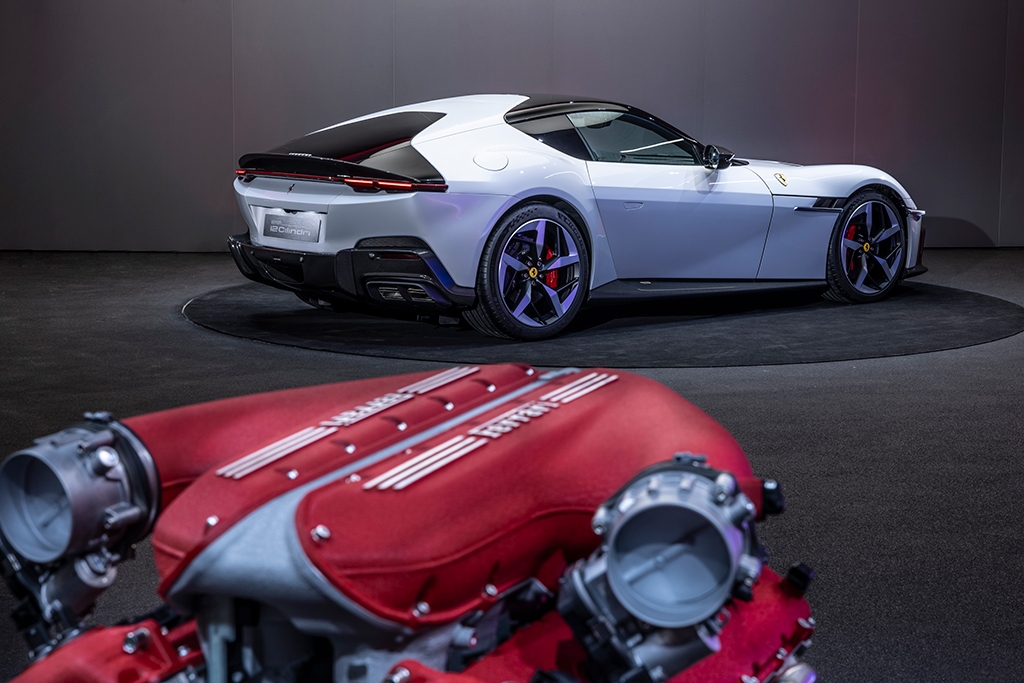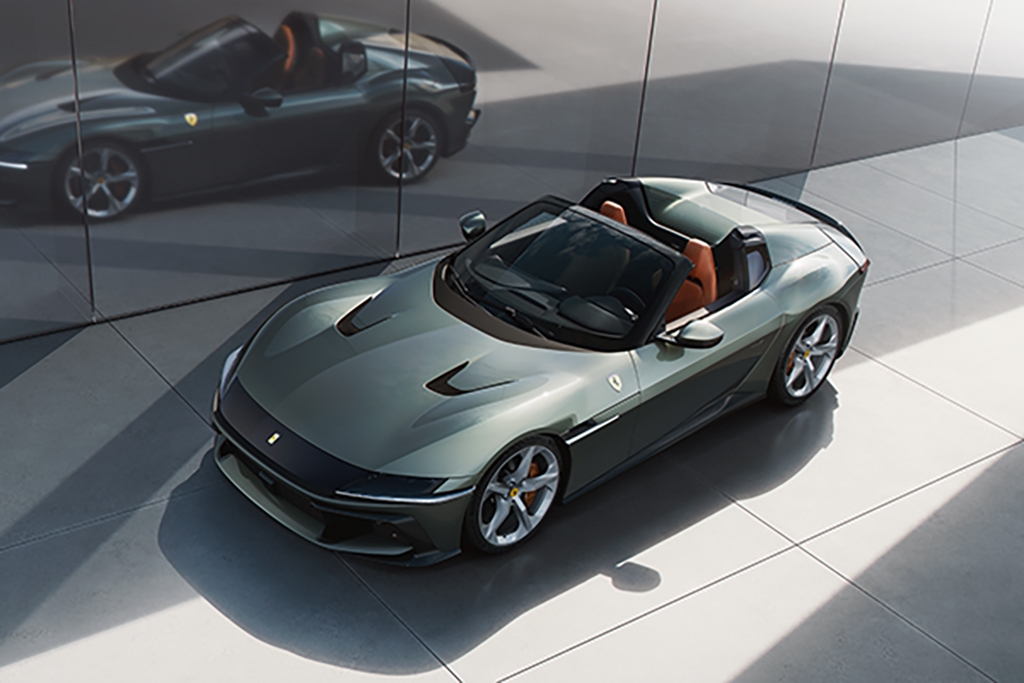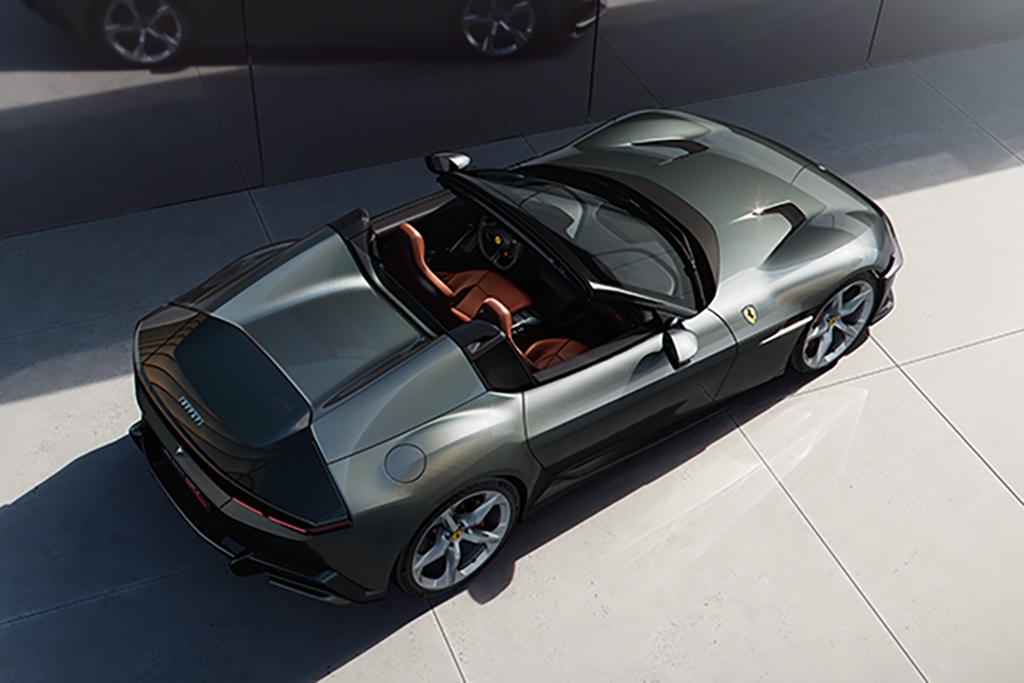Ferrari unveils its newest V12 model, the Ferrari 12Cilindri
03 May 2024|8,866 views
12 cylinders.
The 'Ferrari' name conjures up a multitude of images: Roaring mid-engine sports cars, soul-stirring grand tourers, screaming Formula 1 cars, Michael Schumacher.
But it is 12 cylinders that is the one, single thread that is the through line across the brand's entire history - specifically, the naturally aspirated V12. And that long lineage now births a new model - the new Ferrari 12Cilindri.
Pronounced dodici cilindri (Italian, of course, for 12 cylinders), this is the latest in Ferrari's long line of front-mid-engine, naturally aspirated V12 grand tourers.
And in a radical departure from tradition (and the brand's effort to "be unpredictable"), Ferrari is launching not just one, but two models - unveiling both the Coupe and the Spider concurrently at the launch event held in Miami.
Test of time
Replacing the 812 Superfast, the new 12Cilindri represents the next (and hopefully not last) chapter in the Ferrari V12 story.
Since the original 1.5-litre V12 found in the very first Ferrari car in 1947, Ferrari's iconic 12 cylinder engine has grown to a massive 6.5-litres, which in this new model now outputs 819bhp and 678Nm of torque, 30bhp more than before (it's the same engine found in the special edition 812 Competizione).
A number of optimisations like redesigned con-rods, pistons, crankshaft and intake system mean that this engine revs all the way to 9,500rpm.
But, it’s not just about maximum output. Sliding finger followers in the valvetrain (a technology derived from Formula 1) reduces friction at critical points and helped improved overall mechanical efficiency.
And, a new Aspirated Torque Shaping feature, which helps sculpt the torque curve in third and fourth gears, is designed to improve the perception of torque, allowing drivers to feel an endless swell of torque as they power up through the gears.
Speaking of gears, the 12Cilindri now gets an eight-speed DCT gearbox, with shorter gear ratios and 30% faster gear shifts to deliver a more engaging driving experience in all gears, while also offering added efficiency for motorway driving.
All that power from the naturally aspirated V12 is sent to the car's rear wheels, allowing the 12Cilindri to complete the century sprint in an astonishing 2.9 seconds, and onwards to a top speed of over 340km/h.
A new design
While the V12 powertrain may be familiar, the rest of the car is new.
Underpinning it is a reconfigured chassis that has a 20mm shorter wheelbase compared to the 812 Superfast, but with 15% improved torsional rigidity.
And of course, atop it sits a brand new body - long bonnet, compact passenger compartment, typical front-engine GT forms. The design, however, represents a sharp departure from the aggressively sculpted forms of before. At 4,733mm long and 2,176mm wide, the car is notably longer and wider than the 812 Superfast, yet the sleek forms and specific design touches actually allows it to exhibit a more 'classic' design language.
Inspired by the world of aeronautics, the design is both sleek and purposeful, with the objective being "modern yet elegant". This is chiefly guided by the bold line that runs across the flank of the car, and shape themselves into the front visor section. The head lights are also integrated into a single wraparound band from which blade-like DRLs emerge. The forms of the car are made to be purposeful yet seamless, creating a sense of fluidity and muscularity.
The interior retains the almost symmetrical twin-cockpit design found in the latest Ferrari models, but introduces a notable addition: A third screen - 10.25-inches wide, and housing key infotainment controls like climate control. Of course, the driver still gets his/her own digital display with important driving information, whilst the sole passenger also has access to his/her own 8.8-inch display.
This new third screen sits atop a centre tunnel that houses a Y-shaped metal element (echoing the design language of the car's exterior rear section), within which sits the iconic gate shift.
With the Spider, the overall design language of the car is unchanged. With both variants being developed in tandem, few compromises had to be made to account for the convertible model. In fact, the Spider is just 60kg heavier than the Coupe, and all that extra weight is largely due to the retractable hard-top (RHT) - this means minimal additional bracing was required to maintain the cars overall torsional rigidity.
With the Spider, the RHT can be operated at up to speeds of 45km/h, and takes 14 seconds to open or close. The roof zone is completed with a rear screen that can be electrically height-adjusted, offering occupants improved levels of acoustic comfort when driving with the roof down.
Unyielding performance
Being a Ferrari, the 12Cilindri also has to offer scintillating performance. To this end, a key innovation on this car is the active aero flaps at the back, found on either end of the tail section. On top of being a significant design form that informs the shape of the rear deck of the car (what Ferrari calls a 'delta theme'), the two aero flaps also offer important aerodynamic benefits.
According to the Flavio Manzoni, Chief Design Officer of Ferrari, this split-wing solution was designed in place of a more traditional active rear wing - which would have compromised boot space because of the mechanism required. Automatically deploying between speeds of 60km/h to 300km/h, the aero flaps provide the car with additional downforce and stability.
Underneath the car, there is also a ton of aerodynamics at play. Three pair of vortex generators optimised in the wind tunnel help to manage downforce, while seven openings in the front bumper also help to optimise heat dissipation.
The 12Cilindri also comes with Ferrari’s latest generation electronics, including Side Slip Control 8.0, ABS Evo with brake-by-wire, as well as Virtual Short Wheelbase 3.0. The 12Cilindri also features four-wheel independent steering, allowing improved responsiveness through corners combined with better high-speed stability.
For keen customers in Singapore, the new Ferrari 12Cilindri will be previewed during the upcoming Singapore GP in September. There's no word on local pricing as yet, however the car is priced in Italy at €395,000. For some reference, that's a similar Italian price point to the Ferrari Purosangue, which in Singapore is presently priced at S$2.3m before COE.
First deliveries of the car in Singapore are likely to only begin in mid-2025.
12 cylinders.
The 'Ferrari' name conjures up a multitude of images: Roaring mid-engine sports cars, soul-stirring grand tourers, screaming Formula 1 cars, Michael Schumacher.
But it is 12 cylinders that is the one, single thread that is the through line across the brand's entire history - specifically, the naturally aspirated V12. And that long lineage now births a new model - the new Ferrari 12Cilindri.
Pronounced dodici cilindri (Italian, of course, for 12 cylinders), this is the latest in Ferrari's long line of front-mid-engine, naturally aspirated V12 grand tourers.
And in a radical departure from tradition (and the brand's effort to "be unpredictable"), Ferrari is launching not just one, but two models - unveiling both the Coupe and the Spider concurrently at the launch event held in Miami.
Test of time
Replacing the 812 Superfast, the new 12Cilindri represents the next (and hopefully not last) chapter in the Ferrari V12 story.
Since the original 1.5-litre V12 found in the very first Ferrari car in 1947, Ferrari's iconic 12 cylinder engine has grown to a massive 6.5-litres, which in this new model now outputs 819bhp and 678Nm of torque, 30bhp more than before (it's the same engine found in the special edition 812 Competizione).
A number of optimisations like redesigned con-rods, pistons, crankshaft and intake system mean that this engine revs all the way to 9,500rpm.
But, it’s not just about maximum output. Sliding finger followers in the valvetrain (a technology derived from Formula 1) reduces friction at critical points and helped improved overall mechanical efficiency.
And, a new Aspirated Torque Shaping feature, which helps sculpt the torque curve in third and fourth gears, is designed to improve the perception of torque, allowing drivers to feel an endless swell of torque as they power up through the gears.
Speaking of gears, the 12Cilindri now gets an eight-speed DCT gearbox, with shorter gear ratios and 30% faster gear shifts to deliver a more engaging driving experience in all gears, while also offering added efficiency for motorway driving.
All that power from the naturally aspirated V12 is sent to the car's rear wheels, allowing the 12Cilindri to complete the century sprint in an astonishing 2.9 seconds, and onwards to a top speed of over 340km/h.
A new design
While the V12 powertrain may be familiar, the rest of the car is new.
Underpinning it is a reconfigured chassis that has a 20mm shorter wheelbase compared to the 812 Superfast, but with 15% improved torsional rigidity.
And of course, atop it sits a brand new body - long bonnet, compact passenger compartment, typical front-engine GT forms. The design, however, represents a sharp departure from the aggressively sculpted forms of before. At 4,733mm long and 2,176mm wide, the car is notably longer and wider than the 812 Superfast, yet the sleek forms and specific design touches actually allows it to exhibit a more 'classic' design language.
Inspired by the world of aeronautics, the design is both sleek and purposeful, with the objective being "modern yet elegant". This is chiefly guided by the bold line that runs across the flank of the car, and shape themselves into the front visor section. The head lights are also integrated into a single wraparound band from which blade-like DRLs emerge. The forms of the car are made to be purposeful yet seamless, creating a sense of fluidity and muscularity.
The interior retains the almost symmetrical twin-cockpit design found in the latest Ferrari models, but introduces a notable addition: A third screen - 10.25-inches wide, and housing key infotainment controls like climate control. Of course, the driver still gets his/her own digital display with important driving information, whilst the sole passenger also has access to his/her own 8.8-inch display.
This new third screen sits atop a centre tunnel that houses a Y-shaped metal element (echoing the design language of the car's exterior rear section), within which sits the iconic gate shift.
With the Spider, the overall design language of the car is unchanged. With both variants being developed in tandem, few compromises had to be made to account for the convertible model. In fact, the Spider is just 60kg heavier than the Coupe, and all that extra weight is largely due to the retractable hard-top (RHT) - this means minimal additional bracing was required to maintain the cars overall torsional rigidity.
With the Spider, the RHT can be operated at up to speeds of 45km/h, and takes 14 seconds to open or close. The roof zone is completed with a rear screen that can be electrically height-adjusted, offering occupants improved levels of acoustic comfort when driving with the roof down.
Unyielding performance
Being a Ferrari, the 12Cilindri also has to offer scintillating performance. To this end, a key innovation on this car is the active aero flaps at the back, found on either end of the tail section. On top of being a significant design form that informs the shape of the rear deck of the car (what Ferrari calls a 'delta theme'), the two aero flaps also offer important aerodynamic benefits.
According to the Flavio Manzoni, Chief Design Officer of Ferrari, this split-wing solution was designed in place of a more traditional active rear wing - which would have compromised boot space because of the mechanism required. Automatically deploying between speeds of 60km/h to 300km/h, the aero flaps provide the car with additional downforce and stability.
Underneath the car, there is also a ton of aerodynamics at play. Three pair of vortex generators optimised in the wind tunnel help to manage downforce, while seven openings in the front bumper also help to optimise heat dissipation.
The 12Cilindri also comes with Ferrari’s latest generation electronics, including Side Slip Control 8.0, ABS Evo with brake-by-wire, as well as Virtual Short Wheelbase 3.0. The 12Cilindri also features four-wheel independent steering, allowing improved responsiveness through corners combined with better high-speed stability.
For keen customers in Singapore, the new Ferrari 12Cilindri will be previewed during the upcoming Singapore GP in September. There's no word on local pricing as yet, however the car is priced in Italy at €395,000. For some reference, that's a similar Italian price point to the Ferrari Purosangue, which in Singapore is presently priced at S$2.3m before COE.
First deliveries of the car in Singapore are likely to only begin in mid-2025.
Latest COE Prices
April 2025 | 2nd BIDDING
NEXT TENDER: 07 May 2025
CAT A$99,500
CAT B$117,003
CAT C$65,001
CAT E$118,001
View Full Results Thank You For Your Subscription.












































